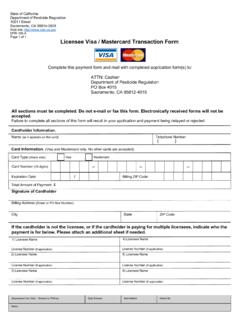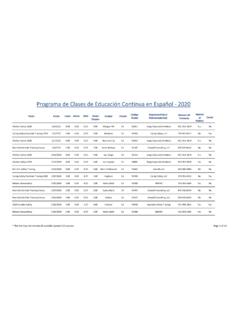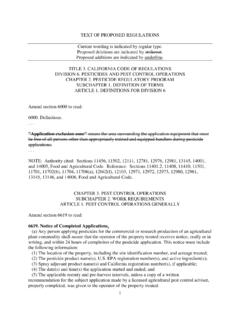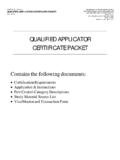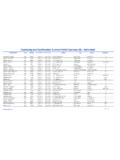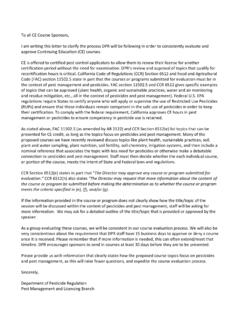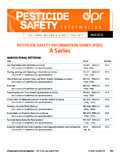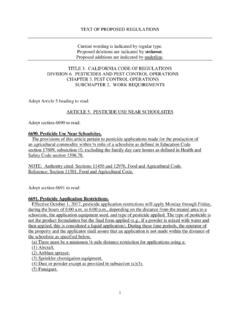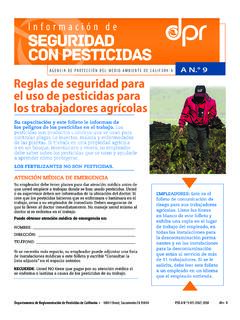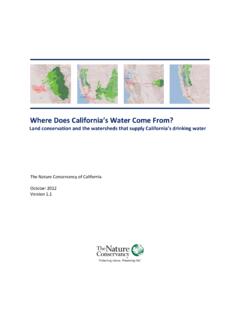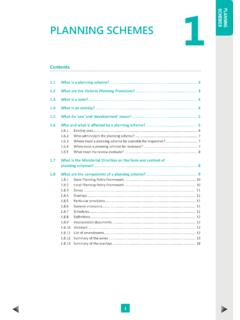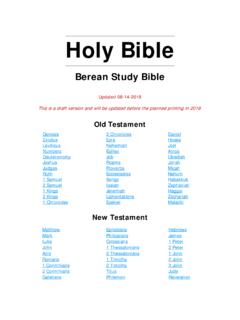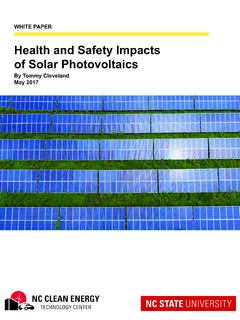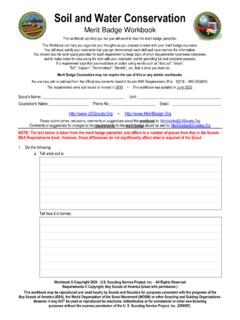Transcription of A Guide for Pesticide Registrants
1 A Guide for Pesticide RegistrantsCalifornia Department of Pesticide Regulation2 | Pesticide Registration Manual: Chapter 1 InsideTable of ContentsChapter 1: Introduction to Pesticide Registration .. 3 Introduction Overview Authority to RegulateDoes My Product/Device Require California Registration? What is a Pesticide ? Types of Products Types of RegistrationsChapter 2: How to Obtain a New Product Registration .. 11 Quick GuideDetailed Information Cover Letter California Application for Pesticide Registration Six Copies of the Proposed Marketing/Production/Container Label, or if Only Registering a Master Label, the Master Label Data to Support Registration EPA Documentation Application Fees Designated Agents/Representative Letter Chapter 3: Pesticide Product Registrations - General Review Procedures.
2 21 Processing the ApplicationEvaluation ProcessRequirement to Post for Public CommentLicensingOmbudsman Point of ContactChapter 4: How to Maintain a Product Registration .. 27 Label AmendmentsFormula RevisionsCompany Name and/or Ownership Changes and Product Transfers RenewalsProduct Inactivation/DiscontinuanceMill AssessmentRisk AssessmentReevaluationAdverse Effects Reporting RequirementsChapter 5: Pesticide -Related Areas of Interest .. 41 Broker LicensesProp 65 List Doing Business as, A Division of, or A Subsidiary of Two Products with the Same Brand NameATCC Numbers for Antimicrobial Product Section 18 Emergency ExemptionsSection 24(c) Special Local NeedsPesticide Products Prohibited from Schools and Child Care FacilitiesResearch AuthorizationsAppendicesAppendix A: Glossary of Terms.
3 48 Appendix B: Guide for Determining Substantially Similar .. 59 Appendix C: Fact Sheet: Section 18: Emergency Exemptions .. 60 Appendix D: Fact Sheet: Section 24(c): Special Local Need Registrations .. 65 Appendix E: Fact Sheet: Research Authorizations .. 69 Appendix F: Fact Sheet: Experimental Use Permits .. 73 Appendix G: Fact Sheet: California Master Labels .. 78 Appendix H: Fact Sheet: Section 25(b) Pesticide Products Exempt from Registration .. 81 Appendix I: Fact Sheet: Amendment, Notification and Non-Notification Tables .. 84 Index.
4 95 Acknowledgements .. 98On the cover: Diabrotica. In the twentieth century, Diabrotica became a major pest of maize in North America as maize growing areas increased. The practice of continuous maize growing was largely responsible for the expanding range of D. virgifera virgifera. Photo: Alex Wild, Department of Pesticide Regulation | 3 Tips on controlling micePeriodically check for droppings, fresh gnaw marks, and tracks that indicate areas where mice are active. The best time for management tactics is when school is not in session. Monitor year round. Talcum powder or white flour can be used as tracking powder.
5 Disturbed powder or tracks can confirm their presence in areas of suspected activity. If possible, inspect adjacent property because mice may soon invade from this direction. Set traps behind objects, in dark corners, and in places where there is evidence of mouse activity. Use more traps than are thought reasonable. Think prevention: it is more effective to control rodents before their numbers get high. Exclusion is the most permanent form of house mouse control. Seal cracks in building foundations and eliminate all gaps and openings larger than 1/4 inch. German cockroaches: Identify and continue to monitor in kitchens.
6 Pigeons: Remove nests twice per week and modify roosting sites to make the area inhospitable. If ex-clusion fails, trap and euthanize (if released, they will return). Don t feed the pigeons!other pestsChapter 1 Introduction to Pesticide RegistrationTable of ContentsIntroductionOverviewAuthority to Regulate Does My Product/Device Require California Registration?What is a Pesticide ?Types of ProductsTypes of Registrations 4 | Pesticide Registration Manual: Chapter 1 IntroductionOverviewThe purpose of this manual is to provide guidance to the Department of Pesticide Regulation s (DPR) stakeholders on applying for Pesticide product registration and amendments.
7 Topics include: Guidance on determining if a product requires registration. Types of product registrations. Submitting an application for registration of a new product or amendmentof a currently registered product. The internal registration process at DPR. Maintaining a product registration. Other related topics such as mill assessment, enforcement, and to Regulate There are both federal ( ) and state laws that govern the manufacture, sale, distribution, and use of Pesticide products. The federal authority to regulate pesticides is found in the Federal Insecticide, Fungicide, and Rodenticide Act (FIFRA) and the Code of Federal Regulations Title 40 (40 CFR), Parts 150 to 189.
8 The Environmental Protection Agency (EPA) is responsible for regulating pesticides at the federal level. A State s authority to regulate pesticides is found in FIFRA, section 24(a) and reads, A State may regulate the sale or use of any Federally-registered Pesticide or device in the state, but only if and to the extent the regulation does not permit any sale or use prohibited by this Act. DPR is given further authority in the following sections of California law and regulations:California Food and Agricultural Code (law), Division 6, sections 11401 - 12408 California Food and Agricultural Code (law), Division 7, sections 12500-14155 and 15300-15340 California Food and Agricultural Code (law), Division 13, sections 29000-29103 Business and Professional Code (law - structural) Division 3, Chapters Code of Regulations, Title 3, Division 6, sections 6000-6960 California Code of Regulations, Title 16, Division 19, sections.
9 In the field of pesticides, FIFRA clearly states that only the federal government has authority over Pesticide labeling. In other words, no state or local government can dictate what is on a Pesticide product label. However, a state can refuse to allow registration of a product and therefore the possession, sale and use of any Pesticide not meeting its own health or safety standards. States can also adopt regulations more protective of health and the environment than on a product Department of Pesticide Regulation | 5 Does My Product/Device Require California Registration?
10 What is a Pesticide ?California Food and Agricultural Code (FAC) section 12753 defines a Pesticide as any of the following:(1) Any substance or mixture of substances which is intended to be used for defoliating plants, regulating plant growth, or for preventing, destroying, repelling, or mitigating any pest, as defined in FAC Section , which may infest or be detrimental to vegetation, man, animals, or households, or be present in any agricultural or nonagricultural environment whatsoever. (2) Any spray , a pest is defined in FAC section as any of the following that is, or is liable to become, dangerous or detrimental to the agricultural or nonagricultural environment of the state: Any insect, predatory animal, rodent, nematode, or weed.
